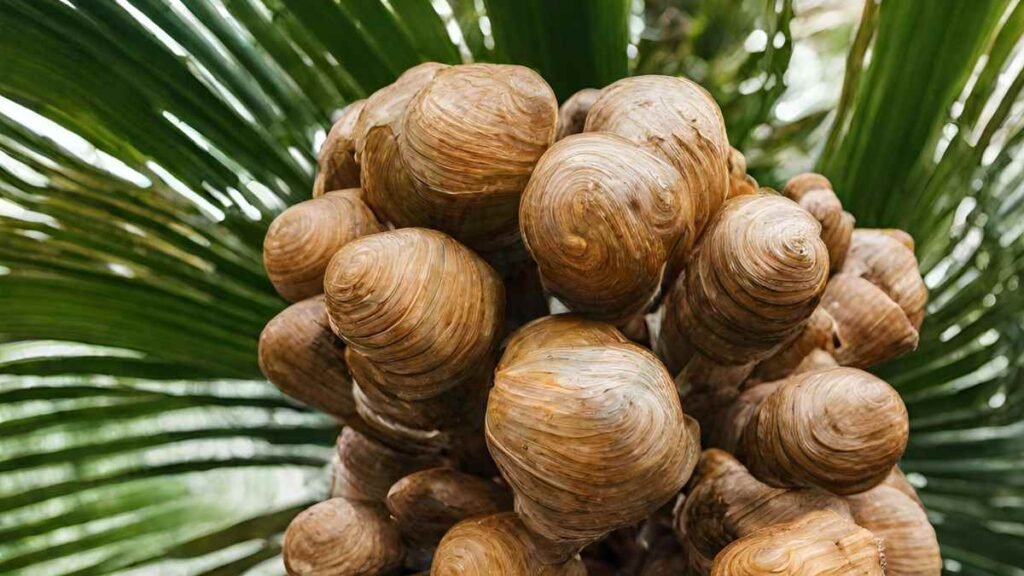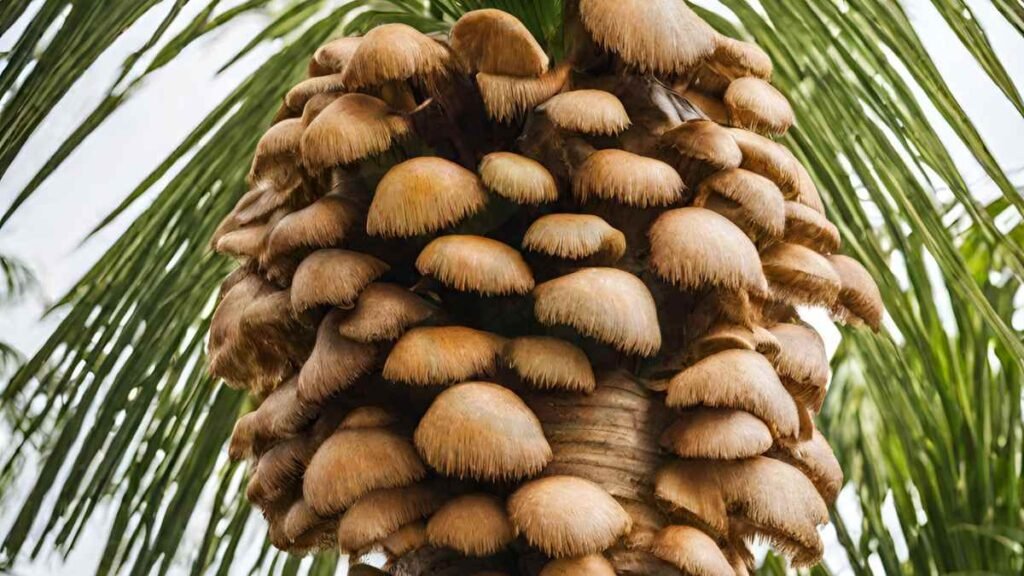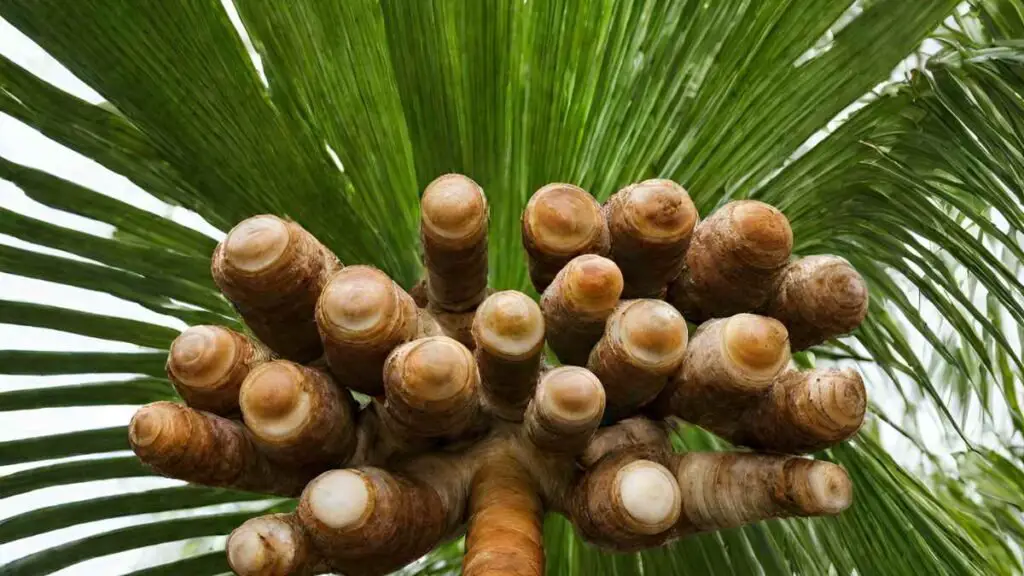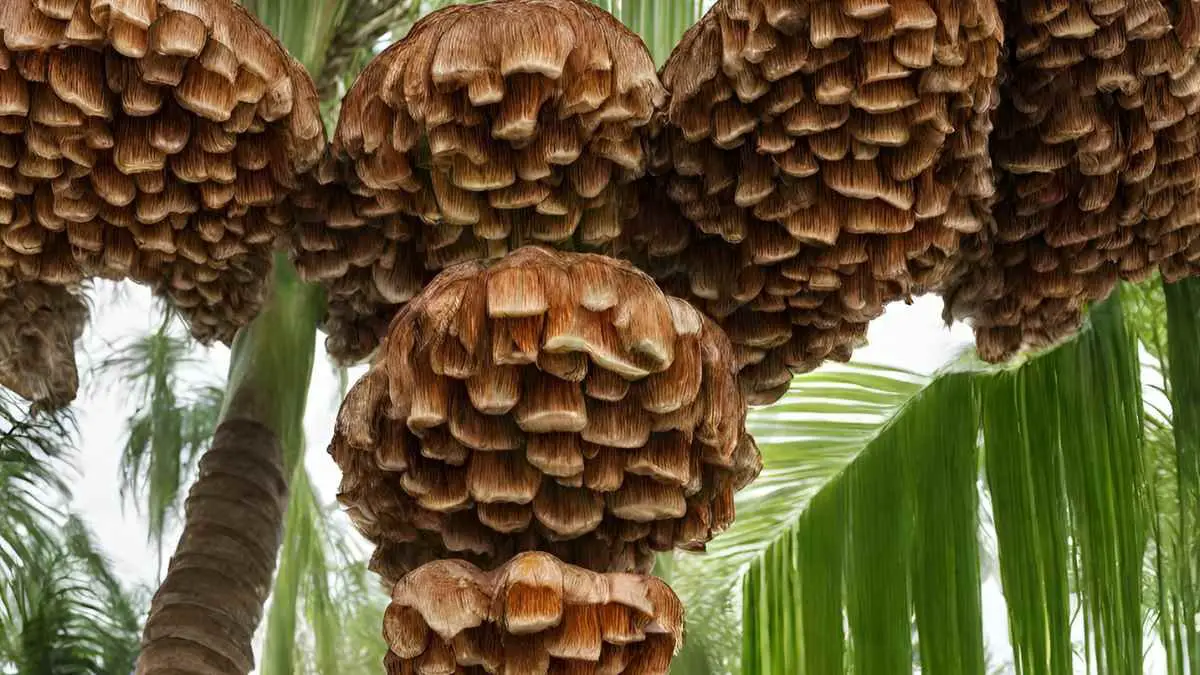Discover the stark reality of dealing with areca palm fungus - a menace that threatens the lush greenery of your indoor oasis. Unveil the challenges faced by plant enthusiasts as they navigate through the devastating effects of this relentless fungal invader, ganoderma butt rot.
Understand the delicate balance between nurturing your beloved areca palm, combating the persistent fungus like ganoderma butt rot that causes peat, and adjusting to each season that seeks to undermine its vitality. Learn how to identify, prevent, and treat areca palm fungus to safeguard the health and vibrancy of your botanical haven.
Key Takeaways
- Properly identifying palm tree diseases, including areca palm fungus, is crucial for effective management.
- Implementing cultural practices such as proper watering and fertilization can help prevent and control palm diseases.
- Regular monitoring and maintenance of palm trees can aid in early disease detection and prompt treatment.
- Effective management strategies, such as pruning infected parts and promoting good air circulation, are essential in controlling palm diseases.
- Treatment options for areca palm fungus may include fungicides or removal of severely infected plants.
- Learning from case studies can provide valuable insights into real-life applications of disease management strategies.
Palm Tree Diseases

Common Types
Fungal diseases commonly affecting areca palms include fusarium wilt, ganoderma butt rot, bud rot, and leaf spot. Each type has distinct characteristics impacting the palm's health and appearance. Fusarium wilt causes wilting and yellowing of leaves, while ganoderma butt rot leads to the decay of the trunk's lower portion.
Bud rot manifests as a softening and discoloration of the bud region, eventually spreading throughout the tree. Leaf spot disease results in dark spots on leaves, affecting photosynthesis. Understanding these differences is crucial for effective treatment and prevention strategies.
Symptoms Overview
General symptoms indicating a fungal infection in areca palms include wilting, yellowing, softening of tissues, and dark spots on leaves. Early recognition is vital to prevent further spread and potential death of the palm tree. Symptoms may vary based on the specific fungus attacking the palm, necessitating prompt intervention.
Recognizing signs like stunted growth, abnormal leaf discoloration, or visible decay can help identify the underlying issue. Timely action can save the palm from irreversible damage caused by unchecked fungal infections.
Diagnosis Tips
Diagnosing fungal infections in areca palms requires keen observation and symptom identification. Regularly inspecting the tree for changes in foliage color, texture, or overall health is essential. Look out for any unusual growth patterns or areas of decay that could indicate a problem.
Consulting with a professional arborist or plant pathologist is advisable if uncertainty persists regarding the diagnosis. Their expertise can provide accurate insights into the type of fungus present and recommend suitable treatment options to restore the palm's health.
Areca Palm Fungus

Identifying Symptoms
Fusarium wilt in areca palms manifests as yellowing and wilting fronds, starting from the lower leaves. Ganoderma butt rot causes a conk or mushroom-like growth near the base of the trunk. Bud rot leads to the collapse of new emerging fronds, often accompanied by a foul smell. Leaf spot diseases present as dark spots or lesions on the foliage.
Visual cues for fusarium wilt include progressive yellowing and browning of leaves, while ganoderma butt rot shows visible conks at the base. Bud rot is identifiable by decaying bud structures and a putrid odor, whereas leaf spot diseases exhibit distinct dark spots on the leaves.
Accurate symptom identification is crucial for targeting specific treatments tailored to each fungal infection. Misdiagnosis can lead to ineffective treatment and further spread of the disease within the areca palm population.
Diagnosis Process
Start by observing any unusual signs like discoloration, wilting, or abnormal growth patterns on the plant. Conduct research to compare observed symptoms with known fungal diseases affecting areca palms. Consult with local arborists or plant pathologists for expert opinion and confirmation of diagnosis.
Early diagnosis allows for timely intervention and prevents extensive damage to the areca palm population. Research plays a vital role in understanding different fungal pathogens that could affect these plants. Consulting professionals ensures accurate diagnosis and appropriate treatment plans.
Other Palm Diseases

Ganoderma Butt Rot
Ganoderma butt rot is a destructive fungal disease that affects areca palms, leading to rapid tree decay. The fungus attacks the lower trunk, causing structural instability. As the disease progresses, affected palms exhibit symptoms such as wilting fronds and conk formations at the base.
The urgency of addressing ganoderma butt rot lies in its ability to spread quickly to nearby trees through root contact. Once infected, the palm's structural integrity weakens, posing risks of toppling over during storms or high winds. Removing and destroying infected trees promptly is crucial to prevent further disease transmission.
Nutritional Problems
Nutritional deficiencies can weaken areca palms, making them more susceptible to fungal infections like ganoderma butt rot. Common issues include inadequate levels of potassium, magnesium, and manganese, which compromise the tree's immune system. These deficiencies hinder the palm's ability to fight off pathogens effectively.
Maintaining optimal nutrient levels in areca palms is essential for promoting overall health and resilience against diseases. Regularly fertilizing with a balanced blend containing necessary micronutrients can help prevent nutritional problems and boost the tree's immune response. Adequate watering and proper drainage also play a vital role in nutrient absorption and utilization by palm trees.
Disease Life Cycle
Fungus Development
Fungal development in areca palms progresses through several stages, starting with spore germination on the palm's surface. Moisture and warmth are key growth factors that facilitate fungal colonization and penetration into the palm tissues. The fungus then establishes itself within the plant, leading to visible symptoms such as leaf spots or wilting.
Environmental conditions play a crucial role in promoting fungi proliferation within areca palms. High humidity levels create an ideal setting for fungal growth, while poor air circulation exacerbates the spread of spores. To disrupt the fungus development cycle, practices like pruning infected leaves and improving drainage can help control infections effectively.
- Key Growth Factors:
- Spore germination
- Moisture and warmth
- Fungal penetration
- Strategies for Control:
- Pruning infected leaves
- Improving air circulation
- Enhancing drainage systems
Spread Mechanisms
Fungal diseases spread among areca palms through various mechanisms, primarily facilitated by contaminated sources. Contaminated soil harbors fungal pathogens that can infect healthy palms upon contact. Water acts as a carrier for spores, spreading them to neighboring trees during irrigation or rainfall events.
Contaminated tools used for pruning or maintenance tasks also play a significant role in transmitting fungal pathogens among palm populations. Preventing the spread of infections requires strict sanitation measures, including disinfecting tools between tree treatments and avoiding cross-contamination between diseased and healthy palms.
- Spread Mechanisms:
- Contaminated soil
- Water transmission
- Tool contamination
- Prevention Strategies:
- Sanitation practices
- Disinfection of tools
- Isolation of infected palms
Effective Management Strategies
Disease Control
Areca palms are susceptible to various fungal diseases that can severely impact their health. Fungicides play a crucial role in controlling these infections by targeting the fungi causing the diseases. Regular pruning of infected leaves and fronds is also essential to prevent the spread of fungal spores.
Consistent monitoring of areca palms is key to early detection of fungal infections. By identifying signs of disease such as leaf spots or wilting early on, prompt intervention can be implemented. Timely action significantly increases the chances of successful disease control.
- Fungicides: Effective in combating fungal diseases
- Pruning: Essential to prevent spread of infections
- Early Intervention: Vital for successful disease control
Preventive Measures
To prevent fungal infections in areca palms, it is essential to adopt proactive measures. Proper watering practices, ensuring the soil is well-drained and not waterlogged, can help maintain palm tree health. Balanced fertilization provides essential nutrients for the palm's defense against diseases.
Cultural practices such as regular inspection for signs of stress or disease, along with adequate sunlight exposure, contribute to overall palm tree health. Implementing preventive measures not only enhances the aesthetic appeal of areca palms but also promotes their longevity.
- Proper Watering: Maintain well-drained soil
- Balanced Fertilization: Provides essential nutrients
- Regular Inspection: Crucial for early detection
Treatment Options
Chemical Treatments
Chemical treatments, such as fungicides, play a crucial role in managing fungal diseases in areca palms. These treatments work by targeting and eliminating the harmful fungi that cause infections. When using chemical treatments, it is essential to follow the recommended application methods to ensure effectiveness.
Safety precautions should always be observed when applying chemical treatments to areca palms. Protective gear, such as gloves and masks, should be worn to prevent exposure to potentially harmful chemicals. It is important to strictly adhere to the dosage instructions provided on the product labels.
Selecting the most appropriate chemical treatments for specific fungal infections is vital for successful management. Different fungicides may target various types of fungi, so it is essential to identify the specific fungus affecting the areca palm before choosing a treatment. Consulting with a plant specialist can help determine the most effective chemical treatment for the particular fungal disease.
Natural Remedies
Exploring natural remedies and alternative treatments can provide sustainable solutions for fungal diseases in areca palms. Organic solutions, such as neem oil or compost teas, have shown efficacy in controlling fungal infections while minimizing harm to the environment. These natural remedies offer a safer and eco-friendly approach to managing plant diseases.
Integrating natural remedies with conventional management practices can enhance overall disease control strategies for areca palms. By combining natural treatments with chemical options, plant health can be maintained effectively while reducing reliance on synthetic chemicals. This integrated approach promotes a balanced ecosystem within the garden or landscape where areca palms thrive.
Cultural Practices
Soil Health
Maintaining healthy soil is crucial in preventing fungal diseases in areca palms. Factors such as soil composition, drainage, and pH levels significantly impact palm tree health. To enhance soil quality, ensure proper drainage to prevent waterlogging, maintain a slightly acidic pH level of 6-7, and incorporate organic matter like compost to improve soil structure.
Improving soil health creates an environment less conducive to fungal pathogens. By promoting good soil aeration and reducing moisture retention, you can effectively inhibit the growth of harmful fungi. Regularly monitoring soil moisture levels and addressing any issues promptly can help safeguard your areca palms against fungal infections.
Watering Techniques
Proper watering techniques play a vital role in preventing fungal infections in areca palms. Overwatering can lead to root rot, while underwatering can cause stress and make the plant more susceptible to diseases. Establish a balanced watering routine by watering deeply but infrequently, allowing the soil to partially dry out between waterings.
Balanced watering practices promote optimal growth and reduce the risk of fungal diseases. Avoid splashing water on leaves to prevent creating a moist environment ideal for fungal growth. Consider using a soaker hose or drip irrigation system to deliver water directly to the roots without wetting the foliage, minimizing the chances of fungal infections.
Monitoring and Maintenance
Regular Check-ups
Regular inspections and maintenance are vital for the health of areca palms. Conducting routine check-ups helps in detecting early signs of fungal infections, ensuring timely intervention. To maintain the well-being of palm trees, a thorough examination checklist is recommended.
It is crucial to emphasize the significance of regular inspections as they enable early detection of any potential fungal issues. By conducting routine check-ups, gardeners can promptly address any abnormalities or symptoms, preventing the spread of diseases.
- Look for discoloration or spots on leaves
- Inspect the trunk for signs of decay
- Check for any abnormal growths or lesions
- Monitor soil moisture levels and drainage to prevent waterlogging
Professional Consultation
Seeking professional advice and consultation is highly recommended for effective management of fungal diseases in areca palms. Professionals such as arborists or plant pathologists bring expertise and specialized resources to accurately diagnose and treat plant ailments.
Collaborating with experts in the field ensures that areca palms receive appropriate care tailored to their specific needs. Professionals can provide valuable insights into disease prevention strategies, treatment options, and long-term maintenance practices.
- Arborists can offer pruning recommendations
- Plant pathologists can conduct laboratory tests
- Professionals can suggest fungicides or treatments based on specific conditions
Case Studies
Successful Management
Areca palm fungal diseases can be effectively managed through key strategies like regular inspection, proper sanitation practices, and timely intervention. Combining these measures with specific products designed for fungal control enhances success rates. For instance, using season-appropriate fungicides can prevent outbreaks during vulnerable periods.
Comprehensive management involves a proactive approach that includes prevention, early diagnosis, and targeted treatment. Implementing a routine inspection schedule allows for the early detection of any signs of fungal infections. By promptly addressing any issues identified, the spread of diseases can be minimized, ensuring the health of areca palms.
Successful disease management stories serve as valuable learning experiences for areca palm owners. For example, a case where diligent monitoring and immediate action prevented a severe fungal outbreak can inspire others to adopt similar practices. Sharing such success stories highlights the effectiveness of proactive measures in preserving the vitality of these plants.
Treatment Failures
Common reasons for treatment failures in managing fungal diseases in areca palms include misdiagnosis, leading to inappropriate treatments that exacerbate the issue. Improper application of treatments, such as using incorrect dosages or methods, can also contribute to ineffective outcomes. The development of resistance to chemicals used for treatment poses a significant challenge.
Learning from treatment failures is crucial for improving future disease management strategies. Analyzing past cases where treatments were unsuccessful provides insights into areas that require improvement. By understanding why certain approaches failed, adjustments can be made to enhance the efficacy of treatment protocols and increase success rates in combating fungal diseases.
Summary
In understanding palm tree diseases like areca palm fungus, you've learned about disease management strategies, treatment options, and effective cultural practices. By monitoring and maintaining your palms, you can prevent and control diseases effectively. Remember to apply the knowledge gained from case studies to tackle specific issues you may encounter with your areca palms. Stay vigilant in caring for your plants to ensure their health and vitality.
Take action now by implementing the recommended management techniques and regularly inspecting your areca palms for signs of disease. Your proactive approach will not only protect your plants but also contribute to a thriving garden environment. Keep up the good work in maintaining healthy and beautiful palm trees!
Frequently Asked Questions
What are the common symptoms of Areca Palm Fungus?
Areca palm fungus symptoms include yellowing or browning of fronds, black spots on leaves, wilting, and stunted growth.
How can I effectively manage Areca Palm Fungus?
Effective management strategies for Areca palm fungus involve proper watering, good air circulation, avoiding overhead watering, and regular inspection for early detection.
What treatment options are available for Areca Palm Fungus?
Treatment options for Areca palm fungus include fungicides, pruning affected areas, improving drainage, and adjusting environmental conditions like humidity levels.
Why are cultural practices important in preventing Areca Palm Fungus?
Cultural practices such as proper spacing between plants, avoiding overcrowding, and providing adequate nutrition help prevent conditions favorable for Areca palm fungus.
How can I monitor and maintain the health of my Areca Palms to prevent fungus?
Regularly inspect your Areca palms for any signs of disease or stress, ensure proper watering practices, maintain cleanliness around the plants, and promptly address any issues to prevent fungal infections.
Image Source: Paid image from CANVA





